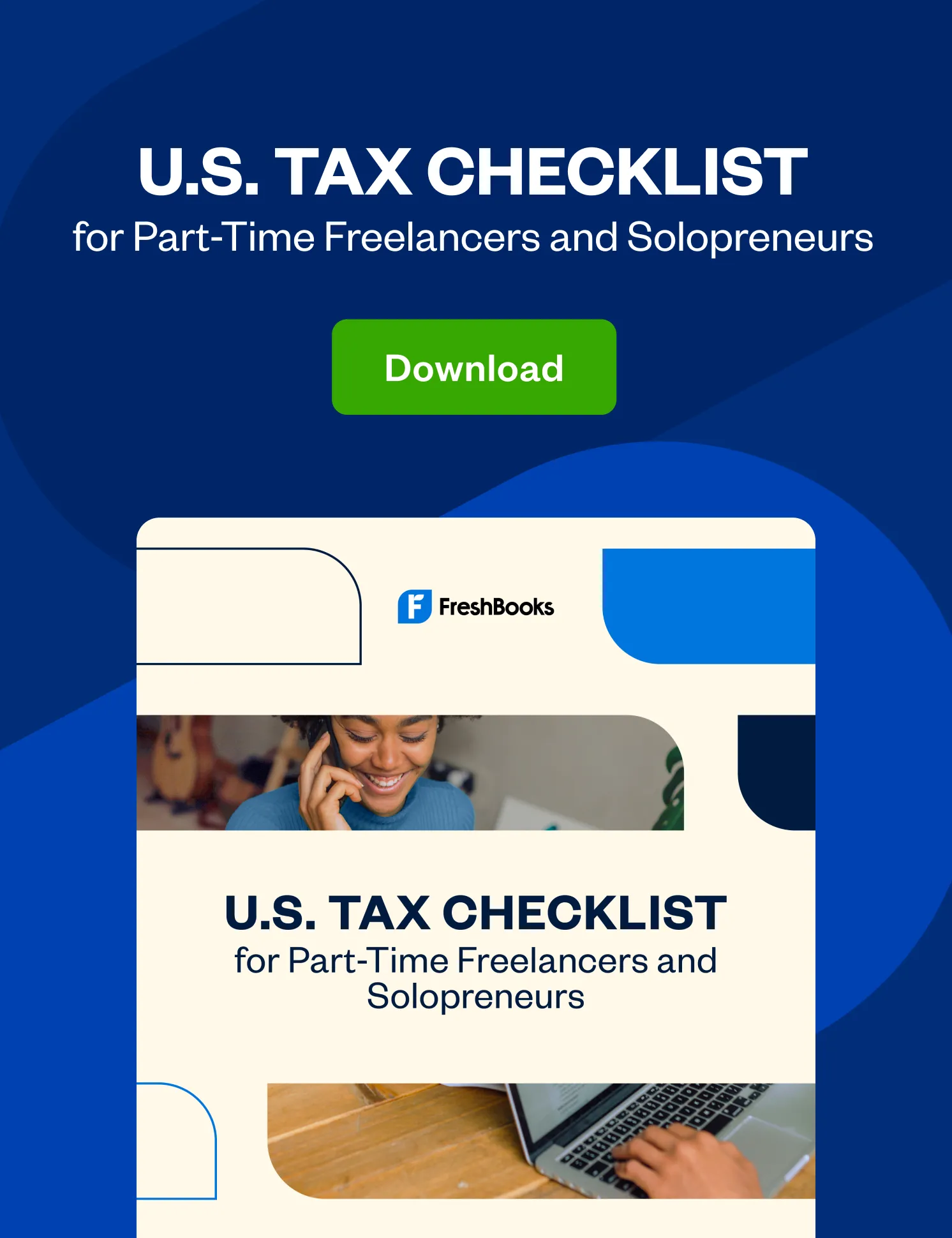Did you remember to pay your quarterly taxes? Tax time comes around more than once a year when you're a business owner.

For freelancers, managing taxes can feel overwhelming. Beyond gathering documents and preparing your tax return (or working with a professional to handle it), you may also need to make quarterly estimated tax payments. This means tax time doesn’t happen just once a year—it happens four times. Surprised? Don’t worry, you’re not alone.
The U.S. follows a “pay-as-you-go” tax system, requiring taxpayers to pay taxes as they earn or receive income. For employees, this happens automatically through federal withholding from paychecks. Freelancers and other self-employed individuals, however, must take charge of their own federal tax payments by making quarterly payments to cover income taxes, self-employment taxes, and other tax liabilities.
Whether you’re new to freelancing and navigating the federal tax payment system for the first time, or an experienced pro looking for a refresher, this guide explains how to determine if you need to pay quarterly taxes and offers strategies for making estimated tax payments with ease.
Table of Contents
So, Who Has to Pay Estimated Quarterly Taxes?
Individuals, including sole proprietors, partners, and S Corporation shareholders, are generally required to pay quarterly estimated taxes if they expect to owe $1,000 or more in federal income taxes after subtracting withholding and refundable credits.
This includes taxes on self-employment income, capital gains, and other types of taxable income. Certain household employers and those with substantial nonwage income, like rental earnings or investments, may also need to make estimated tax payments.
Failing to pay enough tax throughout the year can result in an estimated tax penalty. The Internal Revenue Service (IRS) may also assess penalties for late quarterly tax payments, even if you qualify for a tax refund when you file your tax return. To avoid penalties, it’s essential to pay quarterly taxes on time and ensure your total payments cover your annual tax liability.
How Much Should I Pay in Quarterly Taxes?
Determining how much to pay in quarterly taxes can be tricky because it depends on factors like your taxable income, tax bracket, and eligible deductions or refundable credits. However, your quarterly estimated tax payments must cover both federal income taxes and self-employment taxes.
For the 2024 tax year, self-employment taxes remain at 15.3% of your net self-employment income, which includes Social Security (12.4%) and Medicare taxes (2.9%). To calculate your quarterly payments, take your estimated federal income taxes and add the 15.3% self-employment tax.
If you’re new to freelancing or have fluctuating income, estimating your payments can feel challenging. Start by using IRS Form 1040-ES (found here), which includes a worksheet to help calculate your quarterly estimated tax payments based on your expected adjusted gross income (AGI), tax liability, and eligible credits.
Making estimated tax payments is essential to avoid an estimated tax penalty or underpayment issues. If you overpay, you’ll receive a refund when you file your annual tax return.
Staying organized simplifies the process. Accounting software can help you track income, expenses, and payment history, ensuring accurate calculations for your federal tax deposits. Whether you file through the Electronic Federal Tax Payment System (EFTPS) or use a payment voucher, staying on top of your quarterly payment periods will help keep your tax records in good order and your stress levels low.
The more organized you are, the easier it is. Using accounting software like FreshBooks can help you keep income and expenses organized and simplify the process of paying quarterly taxes.
Understanding the “Safe Harbor” Method
Estimating your tax liability can be complex, but the IRS provides a “safe harbor” method to simplify quarterly tax payments. By following these guidelines, you can avoid an estimated tax penalty, even if your quarterly estimated payments fall short of your final taxable income for the year.
1. Pay 90% of Your Current Year Tax
To meet the safe harbor requirement, pay at least 90% of the tax you owe for the current tax year in four installments. While this is straightforward, it may be challenging to estimate accurately, especially if your income and deductions fluctuate or this is your first year of self-employment income.
2. Pay 100% of Your Prior Year’s Tax
If your income taxes are generally stable year to year, you can base your payments on 100% of the tax shown on your previous year’s return. For example, use Line 24 from your 2023 Form 1040, which reflects the total tax owed before any withholding or refundable credits. Divide this amount by four and pay it in equal installments.
However, if your adjusted gross income (AGI) in the prior year exceeded $150,000 (or $75,000 if married and filing separately), you must pay 110% of last year’s tax liability to qualify for the safe harbor.
3. Use the Annualized Income Installment Method
If your income varies significantly, such as for seasonal freelancers or those earning most of their income late in the year, the annualization income installment method may be a better fit. This method allows you to estimate your quarterly taxes based on actual income and deductions earned to date rather than equal installments.
For example, if your total estimated tax is $20,000 but most of your earnings occur in the last quarter, you can adjust payments accordingly. To use this method, file Form 2210, Underpayment of Estimated Tax by Individuals, Estates, and Trusts, and include Schedule AI with your tax return.
Important Considerations
Even with the safe harbor method, if you expect your income to significantly increase compared to the prior year, you may want to pay quarterly taxes that exceed the safe harbor amount. This strategy helps avoid a large balance due at tax time. The Internal Revenue Service (IRS) recommends keeping detailed tax records and using tools like the Electronic Federal Tax Payment System (EFTPS) to track federal tax deposits and ensure timely payments.
By choosing a safe harbor method and staying consistent with your quarterly payment periods, you can avoid penalties and keep your federal tax payments on track.
How to Plan for Quarterly Estimated Taxes
For many freelancers and small business owners, paying quarterly taxes can be a significant challenge. Having the cash available to make quarterly estimated tax payments on time requires careful planning. Without a solid strategy, you might find yourself scrambling to cover a tax bill when you’d rather reinvest in your business. Once you’ve calculated how much to pay in quarterly taxes, it’s crucial to choose a method to set aside funds for your estimated tax payments.
Here are two practical strategies to help you stay on top of your tax liability:
1. Make Monthly Transfers Into a Savings Account
Let’s say you calculate your quarterly estimated tax obligations for the tax year using the safe harbor method and determine you’ll need to pay $20,000 annually or $5,000 per quarter. That works out to $1,667 per month.
Set up a system to transfer $1,667 to a savings account at the end of each month. You can use this account exclusively for your federal tax deposits, ensuring the money is available when it’s time to make your quarterly estimated tax payment. Automate these transfers using your bank’s online tools or set calendar reminders to help you stay consistent.
This method works well for freelancers with a steady income, as it spreads your federal tax payments out evenly throughout the year.
2. Transfer a Percentage of Each Payment Into Savings
If your income varies, it might make more sense to set aside a percentage of each payment you receive. Start by calculating your estimated total tax liability for the year. Include income taxes and self-employment taxes, which are 15.3% of net self-employment income.
For example, if your taxable income is approximately $100,000 and your federal tax liability is $20,000, that’s 20% of your taxable income. Each time you receive payment from a client, transfer 20% into your savings account.
This approach ensures that your estimated payments reflect your income as you earn it. However, it may result in overpayments if you have significant deductions or expenses, reducing your taxable income. Overpaid taxes can be applied to the next payment period, reducing future quarterly payments or increasing your refund when you file your tax return.
Keep in mind, that if you collect numerous small payments, this method can be time-consuming. Automating percentage-based transfers with your bank or a savings app can save time and help you avoid missing transfers.
By using these strategies, you can effectively plan for your estimated tax payments, ensure you pay enough tax throughout the year, and avoid surprises when quarterly tax payments are due.
When Should You Pay Estimated Taxes?
Quarterly taxes for the 2024 tax year are generally due on the following dates:
- April 15, 2024
- June 17, 2024 (since June 15 is a Saturday)
- September 16, 2024 (since September 15 is a Sunday)
- January 15, 2025
If a due date falls on a weekend or legal holiday, the IRS allows you to make your quarterly estimated tax payment on the next business day without incurring a tax penalty.
You can make an estimated tax payment to the Internal Revenue Service (IRS) by mailing payment vouchers included with Form 1040-ES or using the electronic federal tax payment system (EFTPS). Online options like IRS Direct Pay or the IRS2Go mobile app are fast, secure, and trackable, making it easier to stay on top of your federal tax payments.
State and Local Quarterly Taxes
In addition to federal quarterly tax payments, you may also need to pay state and local estimated taxes. Check with your state’s Department of Revenue or consult a tax expert to ensure compliance with applicable rules, forms, and payment periods. Each jurisdiction may have unique due dates and processes, so plan accordingly.
Managing Quarterly Estimated Tax Payments
Freelancers, small business owners, and individuals with nonwage income, like capital gains or self-employment income, often face challenges in managing variable earnings. If this is your first year making estimated tax payments, start by tracking your taxable income and expenses carefully to calculate your quarterly estimated tax liability.
After the first year, you’ll have a better sense of your safe harbor payments, based on either 90% of the current year’s tax or 100% (or 110%, depending on your adjusted gross income) of the previous year’s tax liability. This helps you avoid penalties for underpaying your estimated taxes, even if your income fluctuates.
By staying organized and using tools like accounting software or the federal tax payment system, you can streamline the process and reduce stress when it’s time to pay quarterly taxes. Remember, paying on time is key to avoiding penalties and ensuring a smoother tax year.
This post was updated in December 2024.

Written by Janet Berry-Johnson, CPA and Freelance Contributor
Posted on July 5, 2018
This article was verified by Janet Berry-Johnson, CPA and Freelance Contributor

 Still Waiting on Your U.S. Tax Refund? Here Are the Reasons for the Hold Up
Still Waiting on Your U.S. Tax Refund? Here Are the Reasons for the Hold Up Fight Your Tax Fears: Do These 5 Things to Pass a U.S. Tax Audit
Fight Your Tax Fears: Do These 5 Things to Pass a U.S. Tax Audit How Your Business Structure Affects Your U.S. Taxes
How Your Business Structure Affects Your U.S. Taxes![2025 Small Business Tax Trends [Free Report]](https://www.freshbooks.com/blog/wp-content/uploads/2025/03/FreshBooks-small-business-tax-trends-report-2025-blog-hero-226x150.png)




